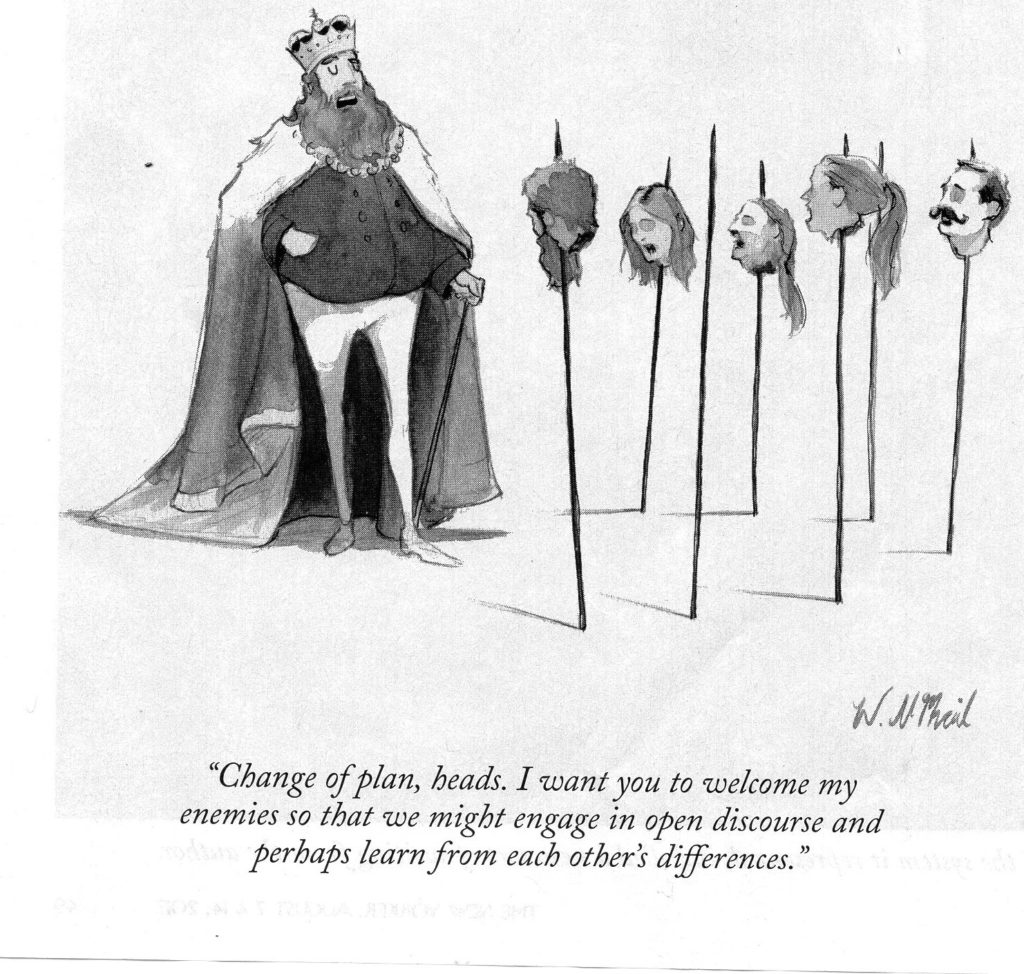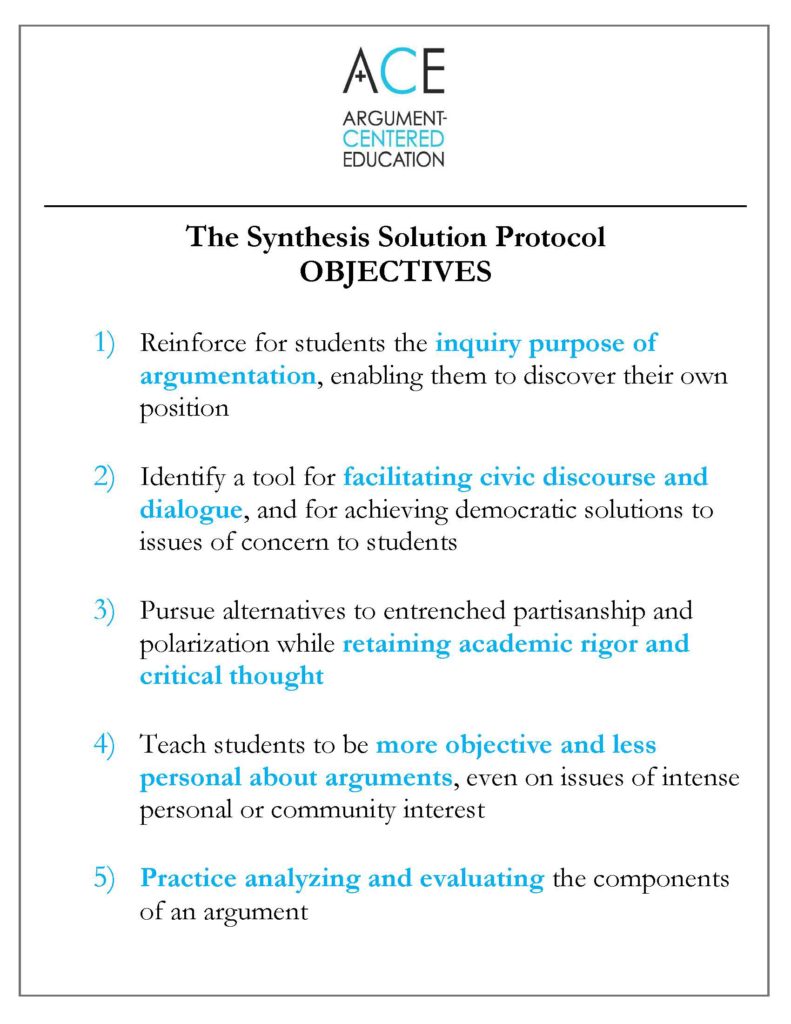
Synthesis Solution Protocol: A Demonstration, Part 1
A prime purpose of critical thinking in the public domain is to consider and evaluate the arguments made on controversial issues. . . . The object is not necessarily to win a debate. Rather, it is to understand what is being said on all sides and, perhaps, to find a nucleus of agreement that will provide a starting point from which we can work together. The idea is to use critical thinking in contributing to healthy human relations and the maintenance of a strong participatory democracy.
— Nel Noddings, professor of philosophy and education, Stanford University, 2017
All those problems [e.g., economic inequality, urban violence, climate change] are serious, they are daunting, but they are not insoluble. What is preventing us from tackling them [is that] we now have a situation in which everybody is listening to those who already agree with them, and are further and further reinforcing their own realities, to the neglect of a common reality, that allows us to have a healthy debate, and then try to find common ground and actually move solutions forward.
— President Barack Obama, 2017
Overview
In a Debatifier post earlier in the summer, I laid out both the pedagogical and the socio-political forces that have impelled Argument-Centered Education to develop what we’ve called a Synthesis Solution Protocol, pushing students to move beyond debate, beyond adversarial and possibly polarized positions, to inquire about and seek a position that combines the best argumentation offered into a synthesized solution or position on the issue under study and argument.
Pedagogically, a growing number of teachers have been asking for resources or support in helping their students to see the higher, inquiry-driven purpose of argumentation and to see beyond side-taking. Those most experienced with academic argumentation and debate have generally internalized that the academic process of taking a position and making arguments for it has as its end a deeper understanding of the complexities of the issue, a closer appreciation of the strengths and weaknesses of all of the major arguments on it, and a unique capacity to generate an independently developed and thoroughly supported position. Academic debate is not really about side-taking, and it is never about side-winning. This is what Stanford University Professor Nel Noddings has in mind when she reminds us in her 2017 book Teaching Controversial Issues that the critical thinking activated by debate has its ultimate purpose not “winning” but “learning,” and specifically learning how to evaluate arguments in the pursuit of finding positions on controversial issues that are true and workable in our democracy.
Noddings’ stance straddles the pedagogical and the socio-political justifications for our new Synthesis Solution Protocol, actually. In a more abstract way, this New Yorker cartoon from July of this year captures the socio-political condition which forms the backdrop of all of our classrooms in 2017/18 America.

To be completely honest, I am not sure that I completely understand the point being made in the cartoon. Is the cartoonist saying that it is late for the King (and by extension all of those in a position of authority today) to call for a less partisan, more open-minded approach to the other side’s viewpoint? Or is the emphasis on the King’s hypocrisy, calling as he is only on those whom he has already beheaded (presumably for their dissent) to give the other side a fair hearing. Whatever the interpretation, what is indisputable is that the cartoon alludes to our hyper-partisan, bitterly oppositional, argue-to-the-death political time that we are living through. It is this tribalist, encamped and entrenched condition that our democracy has to find a way out of, or risk its own immolation in enflamed factionalism division. In address to students at the University of Chicago this past spring, President Obama was – as is his so well-proven wont – so eloquent on this point. Debate is not an end-point in a democracy; it is the process by which all views can be tested and subject to the rigor of critical thought, counter-evidence, reasoned critique, but it should then be followed by a recognition, acceptance of, and coming together around the best and truest arguments so as to construct the most justifiable, often new, position. Even if people’s self-interests do not allow them to fully embrace this resultant position, leaders have the responsibility to form and adopt it, for the benefit of the society as a whole.
What follows in this two-part post is a listing of the specific objectives and stages of the Protocol, and a demonstration of its implementation on a common debatable issue from World Studies or U.S. History.
Objectives
The five objectives that we have identified in integrating the use of the Synthesis Solution Protocol in an argument-centered classroom are listed on this one-pager.

Even though the inquiry purpose – as opposed to the ego-driven argument-winning purpose – in inherent to all argument-centered activities and formats, the Protocol pushes students to recognize this objective explicitly, and not to get stuck in a trench of their own argumentative making. Conference on College Composition and Communication executive committee member Richard Fulkerson endorses this objective in his excellent book, Teaching the Argument in Writing.
I endorse a broad view of argument, a view in which the purpose is not victory over an opponent but mutual dialectical interchange through which, out of opposing yet simultaneously cooperating voices, wise decisions can be reached, decisions always subject to revision as better arguments and better evidence become available.
As the second objective makes clear, use of the Synthesis Solution Protocol serves civics education goals, in that it teaches and practices a method of problem-solving to achieve democratic solutions, one that is sorely absent from both our K-12 curriculum and (even more ominously) our public square. The Protocol reinforces, too, a mode of civic discourse that is intrinsically respectful and civil, since it is built around genuine dialogue.
The third objective listed is in some ways symbolically at the center of the purposes and intention of the Protocol. The default means of thinking syncretically in teaching methods that use debate – and to a lesser extent in the broader political context – is a call for facile compromise. Splitting the difference, finding the mid-point or mean, or similar such appeals are what pass for methods of transcending deep divisions and oppositions. These are too easy, too formulaic to be politically viable, and they are too superficial, too facile to be pedagogically sound. What emerges from what Fulkerson calls “dialectical interchange” must be true to the values of analytical reasoning, scrutiny of evidence, and critical thinking that suffuse the process of argument-centered instruction. The Protocol aims to promote creative, syncretic thinking that is informed by, and that keeps aligned with, the deeper learning that takes place through the process of argumentation. No mean feat.
The fourth and fifth objectives both relate the exercise and development of the skills of argument. The fourth objective is for students to become more objective and less personal in their discourse about issues studied in the classroom, and debated in their communities. This does not imply that students will stop caring – either about the intellectual positions they discover and adopt as their own, or about the interest-directed ones that they advocate for on behalf of their communities – only that they will be better equipped to enter the fray of public and academic discussion and debate from a standpoint that is less about themselves and more about the truth of this issue that is external to themselves. Similarly, students using the Protocol will undertake substantially more analysis and evaluation of arguments, as they pursue a synthesized solution or position through the reflection on argumentation that has taken place on the issue.
Stages
The Synthesis Solution Protocol has five stages in its classroom implementation.

The first two stages map on fully to the five-step argumentalization process. It all starts with the identification of a debatable issue or issues essential to the unit being taught. Content in that unit should be organized by argumentation that can be, should be, or is being made on this issue. Students should engage in an argument-centered activity or project, such as an Argument Exchange, Table Debates, Shaping Arguments, argument writing, an Argument-Based Seminar, or another one of the many formats used by classrooms that implement argument-centered instruction.
Then in the third stage – also, in some ways, the heart of the implementation process, just as the “third” objective is the heart of the Protocol’s purpose – students should undertake a close review and evaluation of the argumentation that has been made, by their side and by the other side (or sides). They will use graphic organizers that guide them through this rigorously reflective process. Teachers can – and at least until the use of the Protocol becomes a classroom routine, are encourage to – collect this review and evaluation for formative assessment.
In the fourth and fifth stages of the Protocol students apply what they have discovered through their review and evaluation to the search for argumentative common ground and a newly synthesized answer, solution, or position in response to the unit’s original debatable issue. In the discussions that guide their inquiry here, students are focused on identifying common or partially shared warrants, assumptions, or standards of evidence across the divide, reflecting on the implications for their positions where they exist and where they do not exist. The two sides play with the arguments that they have made almost as if they were geometric shapes or puzzle pieces, looking for places where they match up and places where they cannot be reconciled. Students also respect instances where the weight of evidence and reasoning strongly favors one opposing argument over the other, and they reflect on the implications of that recognition on the reconfiguring of positions as a whole. They finally aim to each individually put forward a synthesis solution for comparison and relative weighing. The end point is a ranked list of these new positions, with a justification of their ranking.
In Part 2 of this post, coming out soon, we will take a close look at a demonstration of the implementation of the Synthesis Solution Protocol on a debatable issue common to World Studies and U.S. History courses in both middle and high school.
References
Fulkerson, Richard. Teaching the Argument in Writing. National Council of the Teachers of English. 1996.
New Yorker. July 10, 2017.
Noddings, Nel. Teaching Controversial Issues: The Case for Critical Thinking and Moral Commitment in the Classroom. Columbia University Press. 2017
Obama, Barack. University of Chicago Forum on Youth Leadership and Public Service. Online Transcript. April 24, 2017.

